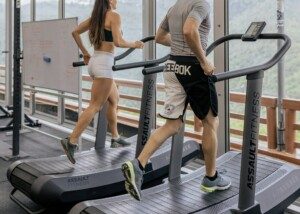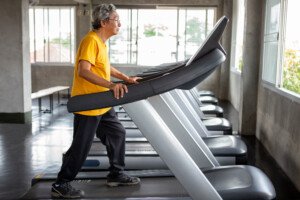
Most elderly people walk on a treadmill wrong, so here are guidelines for individuals of all fitness levels for optimal, safest results.
Most people 65-plus (and younger as well) do not walk on a treadmill correctly.
I’m a former certified personal trainer who has guided many elderly women and men on correct treadmill walking.
How do you walk on a treadmill wrong?
The vast majority of elderly individuals grasp the treadmill’s side rails or front portion while walking.
Though at first, to an unassuming person, this seems like the smart thing to do, it will actually cause much more harm than good.
I want to make it clear that this article pertains strictly to able-bodied elderly people, meaning, they do not require a walker or cane to ambulate, and are functionally sighted.
Most able-bodied seniors hold onto a treadmill. When I ask why, the No. 1 response is fear of falling off, rather than a physical disability or pain.
The next most common reason, believe it or not, is something like, “Everyone else is doing it.”
However, I’ve had clients who reported pain when walking, but then after removing their hands from the treadmill and walking with an arm swing for a few weeks, they reported either elimination of pain or reduction.
One 55-plus woman told me her shoulder pain disappeared.
Another 55-plus woman’s gait, including off the treadmill, improved markedly after she abandoned holding on, even though she had knee osteoarthritis.
Why is holding onto a treadmill harmful, even to elderly walkers?
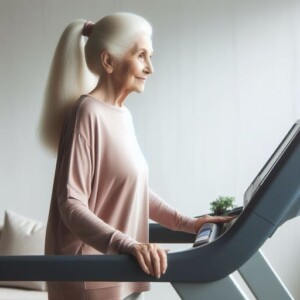
It shuts down the body’s proprioception.
It eliminates the need to balance and know where your body is in space. By shutting this mechanism down, you prevent improving your balance.
The rails balance for you; why should your balance get better? Holding onto a treadmill outright prevents improvement in balance, coordination and ambulation.
“As we get older balance and proprioception are areas that tend to deteriorate,” explains Dr. Charles J. Pelitera, assistant professor of kinesiology and coordinator of the Health/Wellness Program at Canisius College, located in NY.
He continues, “Using a treadmill is a perfect opportunity to work on these areas because it is a controlled exercise with a specific pattern.
“Pumping the arms as opposed to hanging on not only helps with balance but increases cardiovascular output.”
It promotes bad posture.
This is obvious with most walkers who hold on, even young ones, and applies to people of all heights.
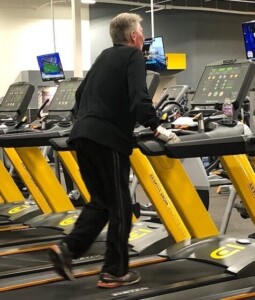
Look at this man’s poor posture. By holding on, he is molding a forward spine and hunched, rigid shoulders. This will have a ripple effect on his hips and knees.
However, depending on height, hand placement on the rails will force one’s shoulders to unnaturally jab up and down with each stride.
Taller individuals may exhibit forward posture. Holding on in front somewhere, as well, will still disrupt walking mechanics.
Regardless of height or where one places their hands, walkers (and joggers) will be forced into unnatural hip motion to compensate for the upper body’s lack of motion.
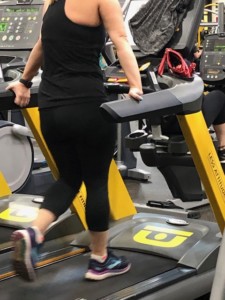
Very unnatural, regardless of age!
This can all be summed up quite simply: Holding on impairs natural gait and posture, and it can result in repetitive stress injuries of the hips, shoulders and even knees.
The last thing an elderly person needs is ruined posture, impaired gait mechanics and a false sense of security when it comes to walking outside.
“Changing of the gait can always lead to injuries, especially soft tissue injuries such as tendinitis,” says Dr. Oliver Zong, DPM, a foot specialist and surgeon based in New York.
He adds: “To the extent that holding onto the treadmill changes one’s gait, this could happen. Clearly it is better to walk or run naturally with a natural gait pattern.”
It’s unrealistic.
When you walk about in the community, you must rely upon your body for balance and control. Holding onto a treadmill fails to prepare you for real-life walking.
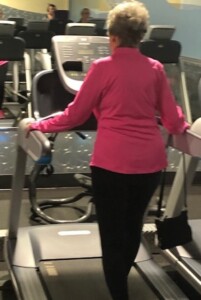
Look at this. How on earth can doing this make her walk more efficiently OFF the treadmill where there’s nothing to hold onto? If all she wants is a faster heart rate, holding on will STILL cause the other harm already explained.
Though one might argue that a treadmill, regardless of how it’s used, is unrealistic, this is actually not true.
One’s feet/legs and core must work to keep up with a moving tread to prevent falling off.
This is exercise, and based on my own experience with treadmill workouts, it definitely transfers to outdoor activity! As long as you swing your arms!
Use the rails or front to momentarily hold on while changing the program, sipping water, rubbing one’s eye, wiping away sweat, turning to greet someone or taking heart rate.
- And by the way, the calorie-reading is meaningless because the treadmill can’t tell if you’re holding on or not.
- Walking without holding on will burn 20 percent more calories.
How can elderly walkers learn to swing their arms on a treadmill?
The user below demonstrates exactly what seniors’ hands should be doing on a treadmill.
And don’t forget, I’m referring to seniors who can walk without assistance in their daily lives.
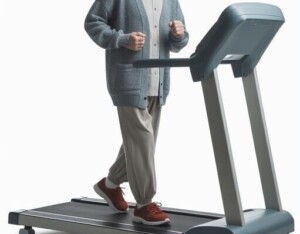
One of the elderly men who had told me he was afraid of falling off had the incline at 15 percent and the speed at 4 mph!
Even my young clients couldn’t maintain a hands-off pace at this intense setting!
If you like a high incline, reduce the speed until you can walk with an arm swing. This will probably be around 1 to 1.2 mph — possibly even less than one mile per hour.
When the incline is maximum, there’s really no such thing as a “too slow” speed.
If you like a fast pace, then reduce the incline. An intense program setting, in combination with holding on, will prove fruitless and waste your time.
To preserve or improve balance, walking efficacy, coordination, fitness, posture and lose weight, it’s crucial that elderly people use an arm swing when walking (or jogging) on a treadmill.
 Dr. Pelitera is the owner of Pelitera Fitness Consultants, which specializes in athletic training, weight loss and strength training.
Dr. Pelitera is the owner of Pelitera Fitness Consultants, which specializes in athletic training, weight loss and strength training.
Dr. Zong, a foot and ankle surgeon, has appeared on national and local TV programs such as “Good Morning America” and “The Doctors.”
 Lorra Garrick has been covering medical, fitness and cybersecurity topics for many years, having written thousands of articles for print magazines and websites, including as a ghostwriter. She’s also a former ACE-certified personal trainer.
Lorra Garrick has been covering medical, fitness and cybersecurity topics for many years, having written thousands of articles for print magazines and websites, including as a ghostwriter. She’s also a former ACE-certified personal trainer.
.



